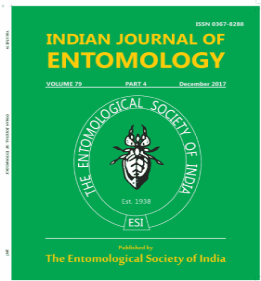Dispersal of Larvae of Fall Armyworm Spodoptera frugiperda in Maize
DOI:
https://doi.org/10.55446/IJE.2023.1516Keywords:
Spodoptera frugiperda, Zea mays, behaviour, larval dispersal, movement, infestation, mean distance, management, sampling, non-directional movement, cages, field, directional movementAbstract
A comprehensive understanding of the pattern of larval dispersal is important to establish the criteria for sampling, statistical analysis and the development of reliable and sustainable management strategies. The fall armyworm, Spodoptera frugiperda (J E Smith) (Lepidoptera: Noctuidae), a notorious pest of maize all over the world was reported from the Indian subcontinent in 2018. The present study assessed plant-to-plant dispersal pattern of larvae of S. frugiperda in caged field conditions of maize. The mean distance travelled by the larvae after infestation ranged from 0.36± 0.36 to 1.05± 0.18 m. The maximum distance travelled by the larvae was up to 1.50 m. There was no significant difference between the number of larvae recovered concerning the direction (n-s) within the row. The distances covered by them in both directions were not significantly different either. The larval dispersal pattern suggested non-directional movement of the caterpillars.
Downloads
Metrics
Downloads
Published
How to Cite
Issue
Section
References
Ali A, Luttrell R G, Pitre H N. 1990. Feeding sites and distribution of fall armyworm (Lepidoptera: Noctuidae) larvae on cotton. Environmental Entomology 19(4): 1060-1067.
Baker R. 1978. Evolutionary ecology of animal migration. Holmes & Meier Publishers, New York. 1012 pp.
Barrows E M. 1975. Individually distinctive odors in an invertebrate. Behavioral Biology 15(1): 57-64.
Bell W J. 1990. Searching behavior patterns in insects. Annual Review of Entomology 35(1): 447-467.
Blickenstaff C C. 1983. Dispersal of western bean cutworm larvae from egg masses as measured by damage to beans. Environmental Entomology 12(3): 902-904.
CABI. 2022. Spodoptera frugiperda (fall armyworm). Invasive Species Compendium. https://www.cabi.org/isc/fallarmyworm (Accessed on 14 July 2022)
Chimweta M, Nyakudya I W, Jimu L, Bray Mashingaidze A. 2020. Fall armyworm [Spodoptera frugiperda (JE Smith)] damage in maize: management options for flood-recession cropping smallholder farmers. International journal of pest management 66(2): 142-154.
EPPO. 2022. First report of Spodoptera frugiperda in New Zealand. EPPO Reporting Service (No. 2022/100). https://gd.eppo.int/reporting/article-7331 (Accessed 7 October 2022)
Fernandes M G, Busoli A C, Barbosa J C. 2003. Spatial distribution of Alabama argillacea (Hubner) (Lepidoptera: Noctuidae) on cotton crop. Neotropical Entomology 32: 107-115.
Ganiger P C, Yeshwanth H M, Muralimohan K, Vinay N, Kumar A R V, Chandrashekara K. 2018. Occurrence of the new invasive pest, fall armyworm, Spodoptera frugiperda (J.E. Smith) (Lepidoptera: Noctuidae), in the maize fields of Karnataka, India. Current Science 115(4): 621-623.
Garcia A G, Malaquias J B, Ferreira C P, Tome M P, Weber I D, Godoy W A C. 2021. Ecological modelling of insect movement in cropping systems. Neotropical Entomology 50(3): 321-334.
Harris M O, Miller J R. 1984. Foliar form influences ovipositional behaviour of the onion fly. Physiological Entomology 9(2): 145-155.
Huang L L, Xue F S, Chen C, Guo X, Tang J J, Zhong L, He H M. 2021. Effects of temperature on life-history traits of the newly invasive fall armyworm, Spodoptera frugiperda in Southeast China. Ecology and Evolution 11(10): 5255-5264.
Johnson S J. 1987. Migration and the life history strategy of the fall armyworm,Spodoptera frugiperda in the western hemisphere. International Journal of Tropical Insect Science 8(4-5-6): 543-549.
Kasoma C, Shimelis H, Laing M D. 2021. Fall armyworm invasion in Africa: implications for maize production and breeding. Journal of Crop Improvement 35(1): 111-146.
Kumar R M, Gadratagi B G, Paramesh V, Kumar P, Madivalar Y, Narayanappa N, Ullah F. 2022. Sustainable management of invasive fall armyworm, Spodoptera frugiperda. Agronomy 12(9): 2150.
Li Y P, Yao S Y, Feng D, Haack R A, Yang Y, Hou J L, Ye H. 2023. Dispersal behavior characters of Spodoptera frugiperda larvae. Insects 14(6): 488.
Martin P B, Wiseman B R, Lynch R E. 1980. Fall Armyworm Symposium: Action Thresholds for Fall Armyworm on Grain Sorghum and Coastal Bermudagrass. Florida Entomologist 63: 375-405.
Montezano D G, Sosa-Gomez D R, Specht A, Roque-Specht V F, Sousa-Silva J C, Paula-Moraes S D, Peterson J A, Hunt T E. 2018. Host plants of Spodoptera frugiperda (Lepidoptera: Noctuidae) in the Americas. African Entomology 26(2): 286-300.
Pannuti L E R, Paula-Moraes, S V, Hunt T E, Baldin E L L, Dana L, Malaquias, J V. 2016. Plant-to-plant movement of Striacosta albicosta (Lepidoptera: Noctuidae) and Spodoptera frugiperda(Lepidoptera: Noctuidae) in maize (Zea mays). Journal of Economic Entomology 109(3): 1125-1131.
Paula-Moraes S, Hunt T E, Wright R J, Hein G L, Blankenship E E. 2013. Western bean cutworm survival and the development of economic injury levels and economic thresholds in field corn. Journal of Economic Entomology 106(3): 1274-1285.
Price P W. 1997. Insect ecology, 3rd edn. John Wiley & Sons, New York. 874 pp.
Ross S E, Ostlie K R. 1990. Dispersal and survival of early instars of European corn borer (Lepidoptera: Pyralidae) in field corn. Journal of Economic Entomology 83(3): 831-836.
Skendzic, Sandra, Monika Zovko, Ivana Pajac Zivkovic, Vinko Lesic, Darija Lemic. 2021: The impact of climate change on agricultural insect pests. Insects 12(5): 440.
Shaw A K. 2020. Causes and consequences of individual variation in animal movement. Movement ecology 8(1): 12.
Sparks A N. 1979. Fall Armyworm Symposium: A review of the biology of the fall armyworm. Florida Entomologist 62(2): 82-87.
Suby S B, Soujanya P L, Yadava P, Patil J, Subaharan K, Prasad G S, Babu K S, Jat S L, Yathish K R, Vadassery J, Kalia V K. 2020. Invasion of fall armyworm (Spodoptera frugiperda) in India: nature, distribution, management and potential impact. Current Science 119: 44-51.
Tavares C S, Santos-Amaya O F, Oliveira E E, Paula-Moraes, S V, Pereira E J G. 2021. Facing Bt toxins growing up: Developmental changes of susceptibility to Bt corn hybrids in fall armyworm populations and the implications for resistance management. Crop Protection 146: 105664.
Taylor L R. 1984. Assessing and interpreting the spatial distributions of insect populations. Annual Review of Entomology 29(1): 321-357.
Zalucki M P, Clarke A R, Malcolm S B. 2002. Ecology and behavior of first instar larval Lepidoptera. Annual Review of Entomology 47(1): 361-393.
















